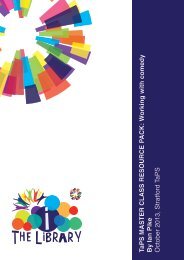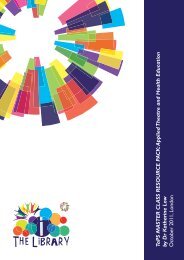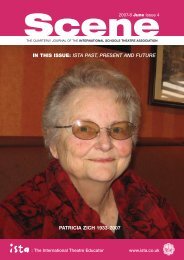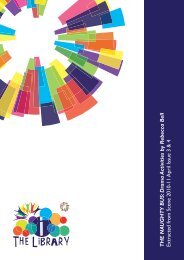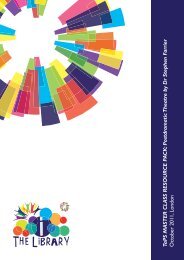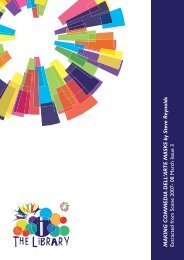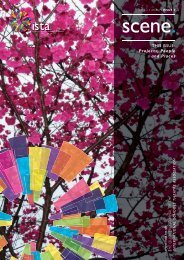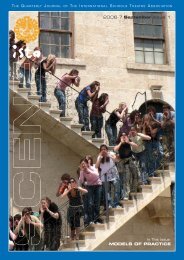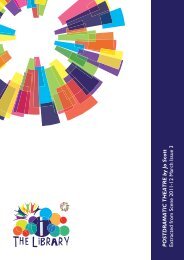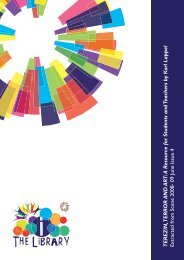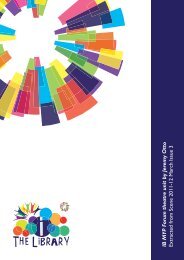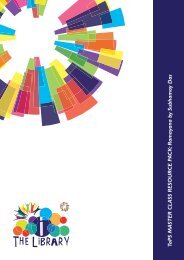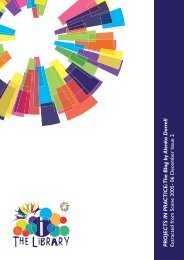ISTA/Scene March 07
ISTA/Scene March 07
ISTA/Scene March 07
You also want an ePaper? Increase the reach of your titles
YUMPU automatically turns print PDFs into web optimized ePapers that Google loves.
ng in Schools<br />
and then set them about the task of<br />
critiquing the idea. Their critiques had<br />
to be based on research and theory as<br />
well as the potential that the idea had<br />
for bringing the play to life on stage.<br />
They were very much the design team.<br />
By the end of May, the idea had been<br />
solidified enough so that one of the<br />
students took on the task of bringing<br />
the costumes to life. She was in<br />
London in the summer and met with<br />
<strong>ISTA</strong>’s David Lightbody to get some<br />
design help. She came back in the fall<br />
with full designs. She then turned<br />
those over to another IB student who<br />
was in charge of actual costume<br />
construction, including fabric<br />
purchasing and working with the tailor.<br />
Nearly all IB Theatre Arts students<br />
were involved in some aspect, either<br />
on stage or off. The process for all the<br />
students was invaluable. They saw the<br />
birth of an idea and worked with it until<br />
they saw it (or acted it) on stage. Their<br />
ability to understand the intricacies of<br />
design and production grew<br />
significantly and the process clearly<br />
impacted their own work. As a school<br />
theatre director/teacher and given<br />
whatever constraints (real or imagined),<br />
I find myself avoiding the same steps<br />
that I require of my students. This<br />
process put into perspective exactly<br />
what I ask them to do on a regular<br />
basis with design and production. It<br />
also gave them the kind of emersion in<br />
a project they do not normally get.<br />
ALL IN THE TIMING and TIME<br />
FLIES: One Act play collections of<br />
David Ives: Vintage Books and<br />
Grove Press, respectively.<br />
I have found this one night production<br />
to be a great way to start a year. At<br />
AES, with students moving in and out<br />
yearly at a rate of about 20%, it is<br />
difficult to know what kind of large<br />
production the students are able to pull<br />
off. An evening of one-acts gives me<br />
as director the ability to choose pieces<br />
of varying difficulty, while at the same<br />
time giving around 20 students the<br />
opportunity to have meaningful roles<br />
on stage. I am a huge fan of David<br />
Ives. His style lends itself to<br />
challenging pieces for talented<br />
performers (SURE THING for example),<br />
but also lets students with less<br />
experience learn the art of timing<br />
(ARABIAN NIGHTS, CAPTIVE<br />
AUDIENCE). The school community<br />
audience can easily tolerate the short<br />
acts and the sophisticated humor<br />
behind Ives. The feedback for the<br />
actors is always instant and gratifying.<br />
COMPLEAT WRKS of WLLM<br />
SHSKPR: abridged, Borgeson,<br />
Long and Singer, Applause Books<br />
This is the most recent production at<br />
AES. Two graduating seniors dragged<br />
their IB teacher on stage to perform<br />
this well-known comedy. The<br />
stipulation from this teacher was that<br />
he have nothing to do with the<br />
production except acting. Students<br />
would be responsible for all elements<br />
of production. They agreed. The play<br />
is an intense production experience in<br />
that while only three actors are on<br />
stage, the supporting crew required 8<br />
members not including the student<br />
director. Most of these 9 were rather<br />
prolific on stage, but had little or no off<br />
stage experience. A baptism by fire!<br />
Again, the play was fine, but the<br />
process was the beneficial aspect.<br />
They really ran all elements of<br />
production-set design, costume<br />
design, posters and tickets, props,<br />
directing: they did it all. The play was<br />
pulled off in four weeks requiring an<br />
intense effort from all. And while the<br />
acting was a great penultimate<br />
experience for the seniors, it is the<br />
students who worked backstage that<br />
still talk about this play. This piece got<br />
the “stage junkies” in the wings to fully<br />
appreciate the enormity of work that<br />
goes into a production.<br />
MY FATHER’S DRAGON based on<br />
the book by Ruth Stiles Gannett<br />
The Thespian Society takes on as its<br />
community service goal to bring<br />
theatre to the drama starved<br />
elementary students. Thespians put on<br />
an annual theatre workshop for grades<br />
3-5 with 50 to 70 students who show<br />
up for the full day of theatre games<br />
and mini-workshops. Two years ago<br />
they extended that to create a full<br />
theatre experience for the students.<br />
The popular children’s story MY<br />
FATHER’S DRAGON had been<br />
adapted to music by the high school<br />
music teacher. It provided a great<br />
vehicle for an elementary show: flexible<br />
casting allowing for between 40 and<br />
70 students, outrageous costumes,<br />
and individual stage time, even for the<br />
smallest of parts. In addition, it meant<br />
that the Thespians could (had to) all be<br />
involved. They managed the entire<br />
production, from audition to closing<br />
curtain. They were in charge of makeup<br />
design and application, costume<br />
design and application, blocking and<br />
direction, choreography, everything.<br />
Calderdale HS<br />
<strong>Scene</strong> | 2006-7 <strong>March</strong> Issue 3 | 3



